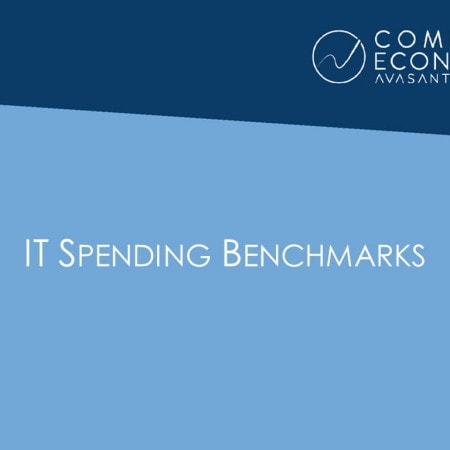-

Outlook for IT Spending and Staffing in 2010
After a year of budget cuts, layoffs, and delayed projects, IT executives can look forward to 2010 as a period of stabilization and rebuilding. Our latest annual fourth-quarter survey shows that median IT budgets will rise slightly in the coming year and that nearly half of all IT organizations are launching new projects. This report assesses the spending and staffing actions IT managers are currently taking, how severely they cut IT spending and staffing over the past year, and what they are including in their budget plans for the year ahead. Our outlook report provides 2010 forecasts for IT operational spending, IT capital spending, and IT hiring by organization size.(26 pp., 25 figs.)[Research Byte and List of Figures]
December, 2009
-

Outlook for 2009 IT Spending and Staffing Levels
To understand how IT decision-makers are responding to the current turmoil in worldwide financial markets, Computer Economics conducted a special survey in October 2008. The results are analyzed in this report, which breaks down changes in IT operational budgets over the past three months and analyzes IT executive expectations for actual 2008 spending versus budget. In addition, we discuss the budget-cutting actions that IT executives have taken over the past three months in response to economic conditions. We also report IT staffing level changes over the past 12 months and IT executive expections for 2009 IT spending and staffing levels by organization size. We conclude with our analysis of why the outlook is not as negative as one might expect. (10 pp., 11 figs.)[Executive Summary]
November, 2008
-

U.S. IT Spending Outlook: The Case for Continuing Concern
In this update of our 2008 IT spending outlook, we provide continuing guidance for IT managers as we approach the fourth quarter. Based on the latest U.S. government statistics, we find overall economic growth strengthening, but weakness in several underlying conditions. The decline in corporate profits across nearly all sectors is most worrisome. Although growth in the information processing equipment and software category is encouraging, we find prospects for growth over the next two quarters to be moderate at best. The report concludes with recommendations for IT executives as well as IT product and service providers in planning their activities in the second half of 2008. (5 pp., 6 figs.)[Executive Summary]
September, 2008
-

Top IT Investment Areas for 2008
According to our study of over 200 IT managers, about 30% of IT spending this year will go towards new initiatives (as opposed to ongoing, "keeping the lights on" spending). But where are those new-initiative dollars going? In this study, we examine where IT organizations are most frequently spending their new-initiative dollars to gain efficiencies, improve service levels, and support business objectives. (5 pp., 8 figs.)[Executive Summary]
July, 2008
-

2008 IT Spending Outlook: Anemic Growth
Although IT operational budgets increased by a healthy 5% this year over 2006 levels, Computer Economics is now detecting a slight bias toward underspending relative to budgets this year. Furthermore, IT executives are now lowering their expectations for increased IT spending in 2008. These trends are most pronounced among large organizations. This article presents the results of our Q4 survey of IT executives and what they mean for the IT spending outlook in 2008. (3 pp., 6 figs.)
November, 2007
-

Ten-Year Trends in IT Spending and Outlook for 2007
This article examines long-term trends in IT spending, combining U.S. economic statistics with proprietary data collected from Computer Economics surveys of several thousand CIOs and senior IT managers in North America over the past 10 years. Long-term trends are analyzed for U.S. GDP growth, growth in U.S. private investment in IT, growth of IT investments by type, IT investment pricing changes by type, IT operational budget as a percent of corporate revenues, IT spending per employee, the percentage of organizations increasing IT budgets, and the percentage change in IT budgets. We use these trends to forecast key IT spending statistics for the coming year. (7 pp., 8 figs.)[Executive Summary]
January, 2007
-

IT Budgets as Percent of Revenue at Highest Level Since 1997
Median corporate IT spending in 2006 across all industry sectors in the U.S. and Canada is 2% of revenue, according to the 17th annual Computer Economics IT Spending and Staffing Study. The most recent three year trend for this metric is provided, along with a link to the full report and executive summary.
July, 2006
-

Long-Term Trends in IT Budget Line Item Ratios
This article, the third in our series on long-term trends in IT spending and staffing, analyzes changes in IT spending on a line-item basis, based on 10 years of data from our IT spending and staffing surveys. Using the ratio of each budget line item to the total IT budget, changes in corporate spending are analyzed for the following categories of IT spending: personnel, training, recruiting, data center hardware (servers and storage), software, desktop and end-user hardware, network infrastructure, outside services, facilities, overhead and supplies, security, and business continuity. By understanding long-term shifts in spending trends, the future direction for spending in each category can be better understood. (14 pp., 12 figs.)[Executive Summary]
May, 2006

 Grid View
Grid View List View
List View